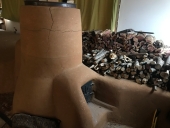posted 6 years ago
Cool project Chris!
I have no first hand experience, but I think your cob will shift/crack much more than you expect(more so than your plaster will be able to hide) - your wood frame will expand/contract as moisture levels change(as your earthen plaster will be vapor-permeable) and will cause cracking, or a least cracks will appear at your frame-to-cob interfaces. So making your cob to the most ideal formulation is probably best to minimize this effect?
Growing on my small acre in SW USA; Fruit/Nut trees w/ annuals, Chickens, lamb, pigs; rabbits and in-laws onto property soon.
Long term goal - chairmaker, luthier, and stay-at-home farm dad. Check out my music! https://www.youtube.com/@Dustyandtheroadrunners









